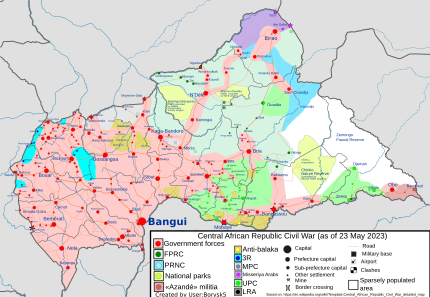Central African Republic Civil War facts for kids
Quick facts for kids Central African Republic Civil War |
|||||||||
|---|---|---|---|---|---|---|---|---|---|
 Current military situation in Central African Republic (For a detailed map of the current military situation, see here) |
|||||||||
|
|||||||||
| Strength | |||||||||
|
ECCAS: 3,500+ peacekeepers |
20,000+ (self-claim, 2022) 3,000 (Séléka claim, 2015) 1,000–2,000 (other estimates, 2014) |
||||||||
| Casualties and losses | |||||||||
| 500+ rebel casualties (Bangui only, South African claim) | |||||||||
|
Civilian casualties:
Unknown number killed or wounded 200,000 internally displaced; 20,000 refugees (1 Aug 2013) 700,000 internally displaced; +288,000 refugees (Feb 2014) Total: Thousands killed 13,594+ killed (Oct 2022) |
|||||||||
The Central African Republic Civil War is a conflict happening in the Central African Republic (CAR). It involves the government, a group called Séléka, and another group known as Anti-balaka. Many of the rebels were fighters from an earlier war in 2004. They said that President François Bozizé broke peace agreements made in 2007. Rebel groups have taken control of many big towns in the central and eastern parts of the country.
Contents
What Started the Conflict?
An earlier conflict, the 2004 civil war, started when a group called the Union of Democratic Forces for Regroupment (UFDR) rebelled against President François Bozizé. This quickly turned into a wider war. However, in 2007, the government and the UFDR made a peace deal. This deal meant that UFDR members would not be punished, their group could become a political party, and their fighters would join the national army.
On March 22, 2013, the rebels broke the ceasefire, which is a promise to stop fighting. They took control of the cities of Damara and Bossangoa. People worried that the capital city, Bangui, would be captured soon, causing a lot of panic.
The next day, March 23, the rebels entered Bangui after heavy fighting near the Government Palace. By March 24, the rebels took control of the government area. President Bozizé fled to the Democratic Republic of Congo. Michel Djotodia became the temporary president of the country. The African Union decided to suspend the Central African Republic because its government had been overthrown.
People Forced to Leave Their Homes
This conflict has caused many people to leave their homes. They are called displaced people or refugees.
How Many People Are Displaced?
- In May 2014, about 600,000 people inside the CAR had to leave their homes. About 160,000 of them were in the capital, Bangui.
- By May 2014, 100,000 people had fled to nearby countries like Cameroon, the Democratic Republic of Congo, and Chad.
- As of 2017, more than 1.1 million people were displaced in a country of about 5 million. This was the highest number ever recorded there.
- About half a million people became refugees outside the CAR, and 600,000 were displaced inside the country.
- Cameroon took in the most refugees, over 135,000. Most of them were from the Fulani group.
New Elections and Peacekeeping Efforts
In February 2016, after a peaceful election, Faustin-Archange Touadéra was chosen as the new president. In October 2016, France announced that it was ending its peacekeeping mission, called Operation Sangaris. France said the mission was a success and largely pulled out its troops.
In December 2020, after a disputed election, a rebel group called the Coalition of Patriots for Change (CPC) took control of main roads. This stopped goods from reaching towns like Bouar. These actions caused about 100,000 people to leave their homes. A month later, in January 2021, this number doubled to 200,000. This included 92,000 refugees in the Democratic Republic of the Congo and 13,000 in Chad, the Republic of the Congo, and Cameroon.
Help from Other Countries
The UN Security Council created a peacekeeping force in April 2014. This force included soldiers from the African Union and France who were already in the Central African Republic. The Central African Armed Forces and UN peacekeepers have been mostly successful in taking back towns from rebel groups. However, there is still a high risk of future rebel activity.
In 2022, the United Nations High Commissioner for Refugees (UNHCR) continued its work to protect and help displaced Central Africans. These people are still waiting for a lasting solution to their situation.
See also
 In Spanish: Segunda guerra civil centroafricana para niños
In Spanish: Segunda guerra civil centroafricana para niños
- List of conflicts in Africa
- Cahier Africain, a documentary that shows one view of the conflict

